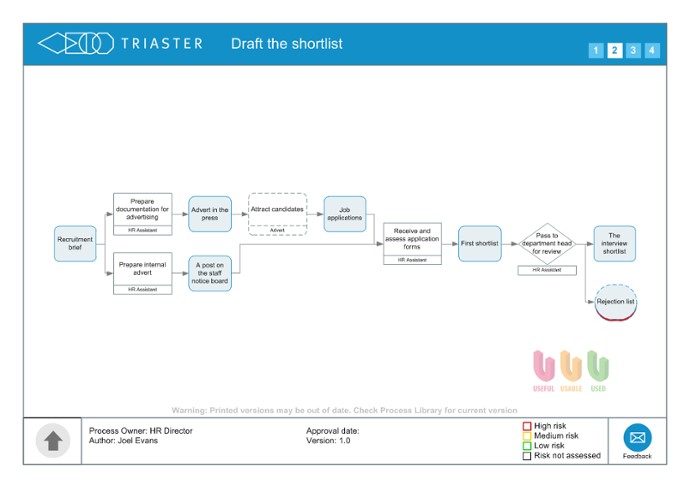A common challenge all organisations have, regardless of their size or sector, is how to get their employees to follow their agreed procedures. This is because employees are people and people are wonderfully and gloriously complex. However, you can ensure that your employees follow your procedures, if you follow 4 key steps.
The 4 keys steps to getting employees to follow procedures are:
- Document your processes and procedures
- Share your documented processes and procedures with your employees
- Build your processes and procedures into your systems
- Create an culture of employee engagement
So how to go about these? Let’s look at each one in turn.
1. Document your processes and procedures
Unless you are a very small organisation, the best way to document what you do and how you do it, is as processes and procedures.
- What you do should be captured as a process
and - How you do it should be captured a procedure
Keeping these distinct is extremely helpful in creating clear and consistent documentation that will actually be helpful to your employees. Those who just want to check what to do (the process), don’t want to have to wade through a whole load of detail (the procedure), which is however very useful to those who don’t know how to do something.

Process mapping and setting out procedures in text form is an excellent way to document how you want your employees to work, because you can create documentation that your employees can easily follow.
A very common reason why employees don’t follow the way you want them to work is because they don’t know what this is. This may be because it hasn’t been written down anywhere or it may be because the way it has been written is just too hard to follow.
If you are a very small organisation, or you just don’t have the bandwidth for this step, with Ask The Crowd you can take a more informal approach and build documenting what you do into step 3.
2. Share your processes and procedures with your employees
Another common reason why employees don’t follow agreed ways of working, even when they have been documented, is because they can’t easily access the documentation.

The key word here is easily. It has to be easier to follow the agreed processes and procedures than to do anything else. This is both about accessibility of documentation and confidence that the information they find is the latest version and following it is definitely the correct thing to do.
For organisations of any size, use of a business management system (BMS) that manages review and approvals and version control, as well as being instantly accessible to all your employees, is essential.
Your business management system should enable employees to:
- Search for the information they need and access it within a maximum of three click
- Present your process and procedures in the way that is most helpful to users – enabling them to just look at the process if that all that’s needed, but to easily access supporting information if they need that
Again for organisations where a formal BMS approach is not feasible, you can build your processes straight into Ask The Crowd (see step 3). It will still be useful to have text based procedures though, for employees to reference when they aren’t sure how to do something.
3. Build your processes and procedures into your systems
Building your processes and procedures into your systems used to be something that only really big organisations could do with ERP systems like SAP. These were big, expensive projects that could end up automating bad ways of doing things.
These days there are tools in the cloud that even very small organisations can use to implement their processes.
Ask The Crowd is Triaster’s process execution platform and it can be used by both organisations that have their processes mapped out and a BPM system in place, and also organisations which have never before thought of what they do as a process.
The organisations which have agreed their processes can easily build them into the Ask The Crowd and those which don’t, can discuss and agree them as part of the Ask The Crowd set up.
Your processes are set up as lifecycles within Ask The Crowd, so that employees are taken through the process step-by-step. This ensures that:
- Everyone has to follow the correct process
- Training is built into the system
- Nothing is lost in the gaps between departments
4. Create a culture of employee engagement
Interestingly this is the step that most organisations find the hardest. It is also the step that is most often neglected. This is because cultural change is much harder than system change. However, it is cultural change that ensures that system changes deliver effectively.
Although I have separated out ‘Create a culture of employee engagement’ as step 4, it does not work in a vacuum. The way to create a culture of employee engagement, is to engage them on many levels. In particular they should be fully involved in steps 1-3.

In the process of doing so you will be able to:
- Discuss and agree what the best ways of working are and why
- Build employee ownership of and responsibility for best practice working
- Embed a process approach and encourage continuous improvement
There is no one way to do this, but there are two essentials to have in place:
1. Senior Management Commitment
Your senior management do need to lead the way with this, if they aren’t supporting the cultural change, why should anyone else?
2. Great Communication Channels
Always important, excellent communication is absolutely essential when you are focusing on what people do and why.
In conclusion
How big a project working through the four steps I have set out here is , will depend on the size of your organisation and the complexity of your processes. For some organisations it will be a big project. To make it more manageable, focus on the areas of your organisation where ensuring that all employees follow procedures is either most problematic or most important, or both.
However for small organisations who can fairly easily get together and capture their business processes in Ask The Crowd lifecycles, it will be much quicker.
Either way, by following these four steps you will definitely get your employees to follow procedures.
Related Articles:
Process vs Procedure: What is the Difference?
What is a Process? And who Cares Anyway?
How To Process Map For Free with Process Navigator
How to Implement Agreed Ways of Working
Related White Papers:
Written by Emma Harris
Emma was Operations Director for Triaster for nearly 20 years, during which time as well as learning and perfecting her BPM and process improvement skills, she honed her inbound marketing expertise. She now runs D2e - Designed to engage - which designs and develops bespoke, engaging, HubSpot CMS websites, that help your entire company to grow and scale. She is delighted to still be delivering Triaster's marketing, whilst also helping other companies turn their websites into their hardest working asset.






